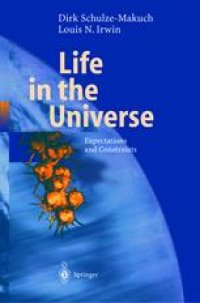
Ebook: Life in the Universe: Expectations and Constraints
- Tags: Biogeosciences, Astrobiology, Biochemistry general, Extraterrestrial Physics Space Sciences
- Series: Advances in Astrobiology and Biogeophysics 3
- Year: 2004
- Publisher: Springer Berlin Heidelberg
- Language: English
- pdf
Energy, chemistry, solvents, and habitats -- the basic elements of living systems – define the opportunities and limitations for life on other worlds. This study examines each of these parameters in crucial depth and makes the argument that life forms we would recognize may be more common in our solar system than many assume. It also considers, however, exotic forms of life that would not have to rely on carbon as basic chemical element, solar energy as a main energy source, or water as primary solvent. Finally the question of detecting bio- and geosignature of such life forms is discussed, ranging from Earth environments to deep space. While speculative considerations in this emerging field of science cannot be avoided, the authors have tried to present their study with the breadth and seriousness that a scientific approach to this issue requires. They seek an operational definition of life and investigate the realm of possibilities that nature offers to realize this very special state of matter and avoid scientific jargon wherever possible to make this intrinsically interdisciplinary subject understandable to a broad range of readers.
Energy, chemistry, solvents, and habitats -- the basic elements of living systems – define the opportunities and limitations for life on other worlds. This study examines each of these parameters in crucial depth and makes the argument that life forms we would recognize may be more common in our solar system than many assume. It also considers, however, exotic forms of life that would not have to rely on carbon as basic chemical element, solar energy as a main energy source, or water as primary solvent. Finally the question of detecting bio- and geosignature of such life forms is discussed, ranging from Earth environments to deep space. While speculative considerations in this emerging field of science cannot be avoided, the authors have tried to present their study with the breadth and seriousness that a scientific approach to this issue requires. They seek an operational definition of life and investigate the realm of possibilities that nature offers to realize this very special state of matter and avoid scientific jargon wherever possible to make this intrinsically interdisciplinary subject understandable to a broad range of readers.
Content:
Front Matter....Pages -
1. Introduction....Pages 1-5
2. Definition of Life....Pages 8-34
3. Lessons from the History of Life....Pages 35-48
4. Energy Sources and Life....Pages 49-76
5. Building Blocks of Life....Pages 77-100
6. Life and the Need for a Solvent....Pages 101-121
7. Habitats of Life....Pages 123-139
8. Ideas of Exotic Forms of Life....Pages 141-147
9. Signatures of Life and the Question of Detection....Pages 149-172